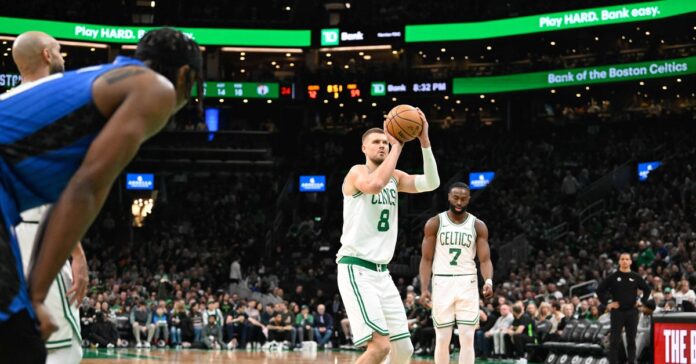Basketball is a numbers game. So, before the Boston Celtics vs. Orlando Magic playoff series, let’s dive into the numbers that could indicate the different tipping points. With 82 games in the books, we can identify clear trends and identities for the two teams. Therefore, to anticipate what the series could look like, here are five metrics that could define the matchup.
Orlando’s mid-range game
The Celtics’ defense has been the best in the NBA at limiting opponents’ eFG% over the last four years. They’ve done it by forcing teams to take inefficient shots. Indeed, the Celtics are allowing only 28.5% of shots at the rim (4th best) and just 8.7% of shots from the corner (1st in the NBA). By taking away the two most efficient zones, the Celtics have become an elite defense.
However, the Orlando Magic aren’t a typical offense. Around Franz Wagner and Paolo Banchero, they’ve built an attack with a lot of mid-range shots. These are usually the ones you don’t want to take, the ones the Celtics try to force you into, but this time might be different.
The Magic have the 6th-highest long mid-range volume across the NBA and will probably try to build on that to disrupt the Celtics’ defense… but can it really work? The Magic are shooting 40% from the long mid-range zone, which is below average and doesn’t seem particularly threatening for Boston.
If the Magic’s stars go berserk for a game, the Celtics’ strategy of leaving the mid-range open could force them to adapt or even cost them a game. But there’s no chance that approach would be sustainable enough to win the series. Making a lot of mid-range shots won’t be enough to fill the gap between the two teams.
Boston’s offensive rebounds
The Magic aren’t as good as the Celtics at impacting opponents’ eFG%, but they are one of the best teams when it comes to turning a miss into a new possession. On the other hand, when the Celtics play big with two centers, they work hard to extend possessions—especially with Luke Kornet on the court.
How will this translate during the series? If the Celtics have a night—or a couple of games—with poor shooting luck, will they be able to win the shot margin battle through offensive rebounds? Since Orlando plays big with two tall ball handlers and very strong centers, some games could turn into a physical battle under the basket.
We could even see a battle between two teams playing with two centers, as the Magic logged over 500 possessions with Goga Bitadze and Wendell Carter Jr. on the court. During those minutes, the Magic have been the best team at preventing offensive rebounds. The few games where the Celtics’ shooting success disappears will be intriguing to analyze. How will the Magic capitalize? What will the Celtics do to compensate for poor shooting luck?
Taking care of the ball
The Celtics are the second-best team at taking care of the ball—unless they’re playing against the Orlando Magic.
Throughout the season, Boston managed to limit its turnover rate to 12%, trailing only the Thunder. However, against Orlando, that rate rose to 16%, which would rank 29th out of 30 teams. This could be problematic on both sides of the floor, as the Celtics have struggled to limit shot attempts off live-ball turnovers.
In the half-court, the Magic doesn’t stand much of a chance against Boston. But if they’re able to force more turnovers than usual, they could turn their elite defense into a good-enough transition offense to push Boston to its limits. That could be enough for Orlando to steal a game, but the Celtics are deep enough to find ways around such aggressive defense.
Getting to the line
The deeper you dive into the data, the more this Celtics vs. Magic series feels like a matchup of polar opposites. The Magic are the second-best team at generating free throws, but 29th in limiting opponent free throws. On the other hand, the Celtics are the best team at taking away free throws, but dead last at getting to the line themselves.
Could that change during the series? We saw last year that the Celtics’ drive volume increased drastically from the regular season to the playoffs as they adjusted to matchups. With the Magic’s inability to protect the rim without fouling, could the Celtics become more aggressive in the paint and increase their presence at the rim?
Celtics three-point volume
The matchup keeps getting more interesting, and three-point volume might be the biggest battle—the one that dictates how the series plays out. The Magic are the best team at taking away the three-point shot thanks to their aggressive defensive coverage and the length of their defenders. Against Orlando, teams attempt just 35% of their shots from beyond the arc, far below the league average of 39%.
However, they’re facing the Celtics—the only team taking more than 50% of their shots from deep. But against the Magic, that number drops to 40%, just above league average. How will Boston adapt to a defense that can neutralize their preferred shooting zone?
All of the Magic’s strengths, weaknesses, and tendencies mentioned above lead me to believe that the Celtics could look very different from the regular season during this matchup. Joe Mazzulla’s team might be far more aggressive at the rim in the coming weeks and could be less oriented toward the three-point shot than usual.






















